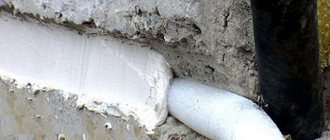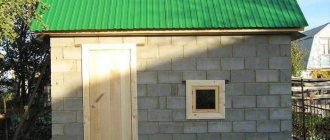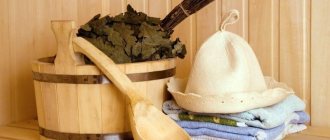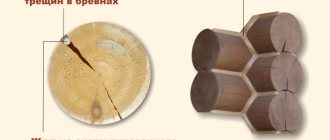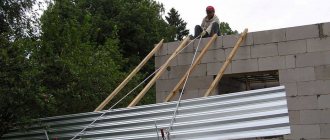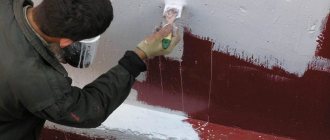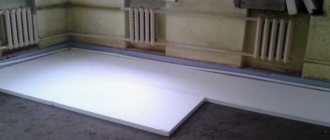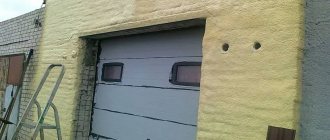Today, steam rooms are very popular. Insulation of a bathhouse is a very important aspect in its arrangement, since the comfort of its operation depends on it. In the absence of proper thermal insulation, the room will not only cool down very quickly, but it will simply be impossible to heat it to the required temperature.
In the photo - materials for insulating a bathhouse
Many people mistakenly believe that insulating a bathhouse made of timber is an unnecessary undertaking, which, in addition to the extra labor and financial costs, does not represent any benefit.
However, as practice shows - and experienced bath attendants will fully confirm this - insulation is necessary both inside and outside the room. This is the only way to achieve minimal heat loss, increase comfort and reduce the cost of heating the room.
What materials are best to use for insulation?
Today, you can find a huge number of different types of insulation on the market, which is why many novice bathhouse attendants face big problems when choosing. It is strictly forbidden to use polystyrene foam and its analogues, since this material is very flammable and also does not allow air to pass through, so during steam procedures, moisture will form on the wood and it will begin to rot over time.
There is no fundamental difference when choosing insulation; you can use any modern material that has high vapor permeability. One of these is mineral wool.
An excellent option for insulating a shower room is flax fiber.
However, it is worth remembering that when heated, it begins to emit substances harmful to human health, so it can only be used for external insulation. To insulate a steam room from the inside, basalt wool or ecowool, which does not have any impregnation and does not ignite at high temperatures, is perfect.
To insulate a shower room, flax fiber and soft fiberboard are an excellent option. These are modern materials that have excellent vapor permeability, as well as a good ability to absorb and release moisture, so that condensation will not form between the timber and the insulation layer, and the wood will not be subject to rotting processes.
As for the use of foil, everything is ambiguous here, since some bathhouse attendants consider it mandatory when insulating a bathhouse, while others do not. If you like higher temperatures during steam procedures and tougher steams, then it will not be superfluous. However, when laying it you must be very careful, since even the slightest mistake can lead to the formation of fungi and rot.
Option for insulating a bathhouse complex from the outside
There are two main options for insulating a steam room - internal and external. Each method has its own pros and cons. Depending on the chosen method, materials for thermal insulation are selected.
An important point: a bathhouse made of profiled timber shrinks at first. This means that gaps may appear between its wooden elements within 1 to 3 years, which will need to be eliminated. If this is not done, then cold air will penetrate through them into the interior of the building. Therefore, it is worth installing capital thermal insulation only after complete shrinkage of the structure.
Advantages:
- the area of the steam room interior does not change;
- it will be possible to keep the “wooden interior” of the bathhouse unchanged;
- the installation of insulating materials will prevent contact of the external walls of the building with precipitation, which contributes to their better preservation.
The disadvantage of external insulation is that a wooden building completely changes its appearance. But you can cover it with clapboard if you wish.
Advantages:
- the appearance of the building does not change;
- the opportunity to decorate the room to your liking.
The disadvantages of internal insulation are a reduction in the area of the room due to the installation of sheathing and thermal insulation materials.
An important point: you need to choose fire-resistant vapor barrier materials. The baths are heated by stoves, so there should be no risk of fire.
Sealing seams is a mandatory process when insulating
There are different ways to protect a building from the negative impact of the environment, but one of the most effective is considered to be a system of ventilated facades. This is an ideal solution for rooms with high humidity, because this design boasts not only excellent energy-saving functions, but also high vapor permeability.
When preparing for work, first of all you need to take care of the insulation. Experts recommend using mineral fiber-based slabs in structures with ventilated facades.
Do you want to know how to do everything strictly according to technology? See instructions:
- Prepare the walls - the process begins with a thorough cleaning of the surface, after which it is necessary to caulk the seams, and at the end treat the walls with an antiseptic. If rot is detected, the log is rehabilitated or replaced if the defect is severe.
- Install the brackets - they are installed on top of a layer of poranite or roofing felt.
- Install the sheathing panels on pre-prepared fasteners - they can be made from galvanized profiles or timber with antiseptic impregnation. The first option is less susceptible to deformation, but in cold weather it acts as a conductor of cold, so it would be more advisable to give preference to wood.
- Place the insulation into the resulting cells - you can prevent the material from falling out with additional fixation with disc dowels.
- Cover the structure with a windproof superdiffusion membrane - only a vapor-permeable film is suitable, which does not allow moisture to accumulate under the skin.
- Finally, cladding is carried out with facing material.
We invite you to familiarize yourself with Siphon for sewerage in a bathhouse
Another option for the correct outdoor “warm pie”
Very often, in an attempt to save money, a consumer seeks to insulate a bathhouse only from the outside, even one made of logs. Is this right or wrong? The answer can be yes if the premises are located in a region where there are no harsh winters. Moreover, the material used for construction by and large does not play any role, the main thing is to carry out the work strictly according to technology. If in a village or city -20 in January is far from the limit, of course it is necessary to additionally insulate it from the inside!
Internal insulation of a timber bath
So, we have already talked about whether it is necessary to insulate a bathhouse made of timber, as well as about the choice of insulation materials, so it’s time to figure out how this actually happens. However, before describing the entire process, it is necessary to remember some nuances.
- When insulating a bathhouse internally, it is necessary to take care in advance of good ventilation of the walls, since without it, during the cold season, dew will form on the walls, which will lead to the appearance of fungus and the onset of rotting.
- In very small rooms, internal insulation of the bathhouse may not be a completely justified measure, since this significantly reduces the internal space of the room.
- If all the nuances are taken into account, then you can proceed directly to insulation, which is carried out in a certain sequence.
- All cracks are sealed on the inside of the wall, after which it is treated with a special construction antiseptic. Next, a frame is made of lathing on the wall.
- The frame cells are filled with insulation. If desired, you can use foil, which will significantly reduce heat loss and protect the insulating material from moisture.
- A gap of approximately 5 centimeters is left necessary for normal air ventilation.
- The wall is covered with clapboard or any other material.
External bath insulation scheme
At this point, the process of insulating a bathhouse made of wooden beams from the inside is completed and you can proceed to similar work from the outside of the room.
When to insulate walls
Buildings made of timber with natural humidity show noticeable shrinkage up to three years. Because of this, cracks and small displacements occur in window and door openings. The owner has to regularly caulk new cracks and eliminate distortions in windows and doors. Large movements can be avoided by using a foundation made of screw piles, but still no finishing is carried out upon completion of construction. It is worth waiting at least 1-2 years and only then starting thermal insulation.
In addition to insulating the walls, several rules help to achieve comfort inside:
- the timber is laid with a ribbon of tow or jute;
- external cracks are clogged with the same material or moss;
- the windows are made low so that the heat under the ceiling does not escape outside;
- doors are built low, narrow, with a high threshold.
The materials used must have good heat resistance and high elasticity. Many putties and polyurethane foam do not have such properties. In addition, it is necessary to choose sealants with high adhesion to wood so that cracks do not form after setting and drying.
External insulation of a bathhouse made of timber
Insulating a bathhouse from the outside involves creating reliable protection for the room from wind and moisture. The whole process looks a certain way.
- As in the case of internal insulation of a bathhouse, the first step is to seal all the cracks on the wall through which cold air can enter the bathhouse and hot air can escape from it, and the timber is also treated with an antiseptic.
- A frame is made of wooden beams, the free space of which is filled with insulating material.
- At the third stage, wind protection and waterproofing are created. For these purposes, it is best to use a PVC membrane, which is a modern building material with excellent characteristics.
- A ventilation gap of approximately 3 centimeters is created. This can be a counter-lattice or any other known method.
- At the final stage, finishing work is carried out.
How to insulate a bathhouse from the inside?
All work on internal insulation is divided into three stages: floor, walls, ceiling. Often the procedure begins with a pre-prepared base. Its base can be either concrete or ordinary soil. In the latter case, you will need to make a sand and gravel cushion on the ground with a layer thickness of no more than 40 cm.
Which wooden bathhouse is the warmest, with a dirt or concrete floor? Of course, the option with cement mortar is more modern and practical, so we will insulate it.
- Cover the concrete base with roofing felt or bitumen mastic;
- Secure the support bars under the joists;
- Install the logs on the supports so that their ends meet the walls;
- The resulting cells between the logs are filled with expanded clay;
The thicker the expanded clay layer, the lower the level of heat loss
- Cover the floor frame with waterproofing film;
- Install insulation between the joists, put mineral wool in the steam room, and foam plastic or expanded polystyrene in the dressing room;
- On top, the structure is covered with a vapor-proof membrane;
- Afterwards, a rough version of the floor is knocked down, onto which the desired material is mounted.
Wall decoration
- Initially, the surface is impregnated with biocidal impregnation;
- Next, the seams are processed - place the material in the grooves between the beams and caulk it thoroughly;
- Apply a moderate layer of sealant on top of the fabric;
- Afterwards, a special frame is installed, similar to what was done outside;
- A heat insulator is placed in it - only material resistant to high temperatures can be installed in the steam room; gypsum fiber, magnesite boards and mineral wool will do;
- A vapor barrier is placed on top - is it worth using foil? It’s not just worth it, it has practically no alternative, well, if you don’t take into account the innovative foil penotherm;
- Next, a frame is mounted to secure the cladding, taking into account the required two-centimeter gap from the vapor barrier layer.
There is no need to rack your brains for a long time about how to insulate the ceiling. From the inside the procedure is similar to the walls, but from the attic it looks a little different.
Ceiling insulation
A little outdated, but still effective ceiling insulation.
Experts say that to minimize heat loss, sealing the outside of the ceiling is mandatory! Let's look at this simple technique:
- Place fiberglass on the ceiling to prevent moisture from entering;
- Mix a solution with high thermal insulation qualities - for this you will need clay, chopped straw, water and sawdust. All ingredients are mixed until thick in one to one proportions;
- Fill the space between the beams with mortar, controlling the level of moisture insulation on the inside of the ceiling;
- Leave the work for several weeks until the solution dries completely;
- Then, dense insulation and a moisture-proof membrane are laid;
- A thin cement screed is poured on top - fixing it.
We invite you to familiarize yourself with Lampshade for a bath (40 photos): shades made of Himalayan salt and corner models, how to choose and install lighting in a steam room
At this point, the complex of work on capital insulation of the bathhouse can be considered completed. Many will wonder whether it is necessary to make so many unnecessary movements for the sake of short-term pleasure? Anyone who wants to feel the real heat of an old Russian bathhouse will definitely say - it’s a must! Moreover, such leisure also has a healing effect.
Steam room insulation
The steam room is the most important room of the bathhouse and its heart, so it also needs insulation. However, thermal insulation in timber baths is much simpler than in a wooden bath or sauna. To minimize heat loss, it will be enough to just seal all the cracks in the wall and lay a layer of foil with a small ventilation gap between it and the lining.
As for the foil itself, as experienced bath attendants say, it is not always necessary. In addition, if the decoration of the steam room will be done with natural coniferous wood, then the use of foil is strictly prohibited, since it will cause the lining to heat up too much, and you will get burned. In fact, the insulation process is not complicated, the most important thing is to follow certain instructions, and then everything will work out.
Some tips for insulating a bathhouse are in the next video.
Required tools and materials
In order to carry out thermal insulation of a bathhouse yourself, you need to prepare the following set of tools:
- construction tape;
- screwdriver;
- building level and plumb line;
- axe;
- chisel;
- saw or hacksaw;
- hammer;
- jigsaw;
- wire cutters or pliers;
- sharp technical knife;
- electric drill or hammer drill.
In addition to the insulation itself, for work you will need:
- vapor barrier film;
- wooden beam;
- metal rail;
- screws and nails;
- adhesive tape.

